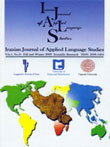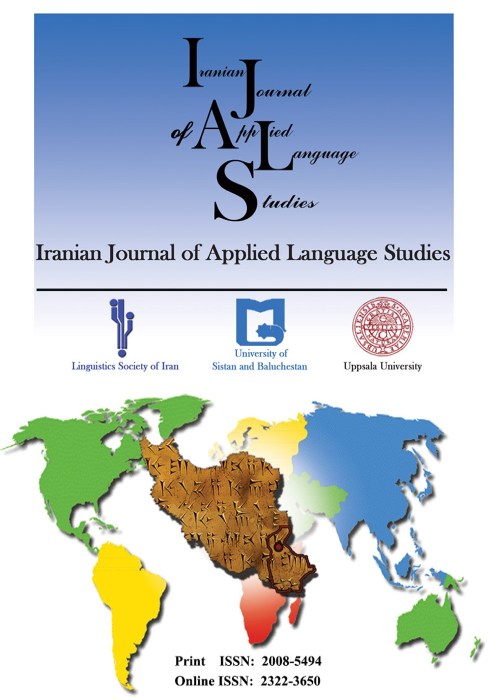فهرست مطالب

Iranian Journal of Applied Language Studies
Volume:8 Issue: 2, Winter and Spring 2016
- تاریخ انتشار: 1395/12/24
- تعداد عناوین: 8
-
-
Pages 1-26Lexical inferencing is one of the most important strategies in vocabulary learning and it plays an important role in dealing with unknown words in a text. In this regard, the aim of this study was to determine the lexical inferencing strategies used by Iranian EFL learners when they encounter unknown words at both text and sentence levels. To this end, forty lower intermediate students were divided into two groups. For the first group, a text with 10 underlined words was given and for the second group, the same underlined words were given in separate sentences. The students were supposed to read the text and the sentences and to guess the meaning of the underlined words. Then some lexical inferencing strategies were given to them to determine which strategies they used in guessing the meaning of unknown words. The results showed that they used different strategies like using local context and word association in lexical inferencing and also they were more successful at the text level than the sentence one. The results also indicated that they were strategic learners using their own strategies including translation and cultural background knowledge to guess the meaning of the unknown words.Keywords: Lexical Inferencing, Strategies, Text Level, Sentence Level
-
Pages 27-50Professional development and professional identity of English language teachers have usually been explored separately in the research agenda. However, there might be a nexus of relationships between professional identity and professional development in the context of English language teaching. This study, therefore, explored how professional identity might contribute to professional development of English language teachers. To this end, 60 English language teachers from inner, 60 from outer, and 60 from expanding circle of language use were sampled to fill in a questionnaire which was constructed and validated by the researchers. The study concluded that language teachers professional development could be theorized on a development of past-present-aspirational identity. It was also found that language teachers professional identity could be improved through development of interpersonal relations, system of knowledge and belief, and intrapersonal identity that would be considered as sub-identities of English language teachers professional identity.Keywords: English Language Teacher, Professional Identity, Teacher Development, Teacher Education
-
Pages 51-72Genuine Criticism (GC) is an evaluative expression of annoyance with an attribute in the interlocutor, whose realization may threaten the positive image of both interlocutors. The current study investigates facework and politeness in performing GCsin different contexts and for interlocutors with low social distance and high status in terms of GC realization strategies and mitigation devices that the speakers employ to soften their criticisms. Data were collected from 70 situations from movies in which GCs arise between interactants. The interactants deal with topics that happen in their daily life. The data were transcribed, categorized and analyzed based on the adapted version of criticizing categorization developed by Nguyen (2005, 2013).The results indicate that interactants with low social distance between them and the speakers who possess higher status employ direct strategies more than indirect strategies when they carry out criticism. Besides, the speakers with higher social distance utilize direct criticizing strategies more often. With regard to mitigation strategies, both groups tend to mitigate their criticisms less often. Exploring the strategies that English NSs employ can help EFL material developers realize and depict a better picture of the strategies in learning materials so that potential learning problems are prevented.Keywords: Genuine Criticism, Mitigation, Politeness, Interactants
-
Pages 73-100In order to be autonomous, teachers should enjoy teaching and be satisfied with their teaching. Teacher autonomy, therefore, may be related to teacher burnout and job satisfaction. The present study investigated the relationship between job satisfaction, teacher burnout, and teacher autonomy. Two hundred and seven language teachers at language institutes in Karaj and Tehran were given three questionnaires to complete. Convenience sampling was used to select language teachers in this study, and IBM SPSS (version 22) was used to analyze the data. Three non-parametric statistical tests were used to analyze the collected data. According to the findings of this study, job satisfaction had a weak negative relationship with teacher burnout, and teacher autonomy correlated negatively with job satisfaction. Moreover, no relationship between teacher autonomy and teacher burnout was found. Although the findings should be interpreted with care because of sample size, the paper ends with implications for language teachers and policy makers.Keywords: Job Satisfaction, Teacher Burnout, Teacher Autonomy
-
Pages 101-124How language teachers talk is a key factor in organizing and facilitating learning specifically in classrooms where the medium of instruction is also the subject matter. This study aimed to examine the extent and ways of teacher talk adaptation to students proficiency levels in Iranian EFL context. Two EFL teachers who were teaching three different proficiency levels were observed and recorded. They were also interviewed to see if they made any conscious effort to adapt to their students level. Furthermore, the students of the same classes were interviewed for the comprehensibility of their teachers talk. Data were analyzed for four major areas of adaptation including speech rate, vocabulary, syntax, and discourse. The results showed that teachers adaptation to students level does happen clearly for elementary students; however, the adaptation boundary between the intermediate and advanced levels is fuzzy. The findings also indicated that in spite of what they think, teachers talk is not tuned to elementary students understanding.Keywords: Teacher Talk, Teacher Talk Adaptation, Student's Proficiency Level, Comprehensible Input, Classroom Discourse
-
Pages 125-168The concept of teacher change is critical in second language teaching and English as a Foreign Language (EFL) context due largely to the fact that, almost, whatever we do in teacher education looks for initiating change of one sort or another. A substantial body of research has been dedicated to investigate teacher change (TC) from various perspectives. However, having studied the related literature, we found no robust, valid and reliable measure for TC in EFL context. Accordingly, effort was made to develop and validate a reliable and valid measure that could assess TC in an EFL context. The review of the prior research resulted in the collection of 186 items affecting TC out of which a temporary data driven model of teacher change was developed. 324 Ph.D. and M.A. graduated EFL teachers took part in exploratory and confirmatory factor analyses of the initial measure. Finally, a 66-item scale consisting of three components and thirteen sub-components was developed.The results showed both factorial validity andinternal consistency reliability for the measure.The TCSsubscales also had strong validity evidence based on the associationsfound. This study has various applications for language teachers and practitioners in the field.Keywords: EFL Teacher Change Scale (EFLTCS), validation, exploratory factor analysis, confirmatory factor analysis
-
Pages 169-198To date, a majority of comparative studies have been conducted to generally shed some light on the concept of pragmatic transfer between a native language and a second or foreign language. However, little research has investigated a multilingual situation where there is an interaction among three different languages spoken by one person. Of interest was whether pragmatic transfer of refusals among three languages spoken by the same person occurs from L1 and L2 to L3, L1 to L2 and then to L3 or from L1 and L1 (if there are more than one L1) to L2. The present study aimed to investigate the norms of production of refusals in three languages under investigation and to specify what impact, if any, the knowledge of these languages has on pragmatic transfer of refusals. To this end, 161 participants in 5 groups filled out a Discourse Completion Test (DCT), consisting of 12 situations on 4 types of refusal speech act. The collected data was coded and analyzed in terms of semantic formula sequences categorizedbased on the refusal taxonomy. The collected data from Kurdish learners of English who were also fluent in Farsi (Trilingual speakers) were compared with data obtained fromotherfour groups: 1)Native English speakers; 2)Monolingual speakers in Farsi; 3) Monolingual speakers in Kurdish; and 4) BilingualFarsi learners of English.The results revealed that pragmatic transfer exists in choice and content of semantic formulae- with the availability of the similar range of refusals.It was also found that the sociocultural norms of English, Farsi, and Kurdish languages differ with respects to the refusal speech act and individual's social power and relative distance play a critical role in performing such a speech act. This research suggests that, in spite of the norm differences existing amongEnglish and two other languages,transferof refusals mostly occurs from Kurdish as L1 but not from L2 (Farsi) to L3 (English). The study results would be used for further research in the field of teaching and learning English as a foreign language.Keywords: Pragmatic Transfer, Refusal Speech Act, Semantic Formulae, Discourse Completion Test (DCT)
-
Pages 199-219This mini-corpus, cross-linguistic comparative and norm-referenced study intends to render the most frequently and oft-used affixes in the written descriptive tasks in the performance of English language materials developers (ELMDs) and Iranian English language undergraduates (IELUs) through a correlation study. Samples of writings of both groups were studied and analyzed through affixation principles and the frequency of nearly 63 affixes both inflectional and derivational morphemes was taken into account. The statistical analysis showed a highly significant correlation (.86) with its (.75) coefficient determination (shared variance) exists between two groups performance and the result of the study on the basis of oft-used affixes bears approximately a close resemblance to the findings by Fry and Kress( 2006), Hoing et al. (2000), Bauer et al.(1982), and White et al. (1989). Finally the implications of the study were taken into account.Keywords: Correlation, Affixation, Morpheme Studies, Frequency, Morphological Awareness


